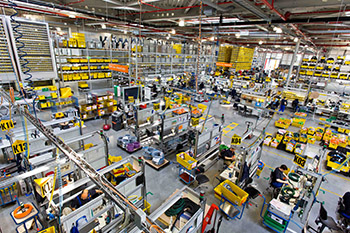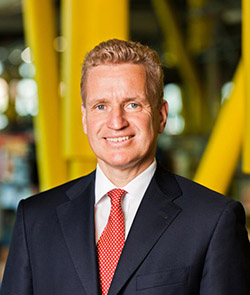 I had the pleasure of touring the international headquarters of igus just after the Hannover Fair this year, and also was able to sit with company CEO Frank Blase. The facility is enormous, yet intelligently designed—it doesn’t feel like a manufacturing plant, due to the light that comes in through strangely organic looking skylights.
I had the pleasure of touring the international headquarters of igus just after the Hannover Fair this year, and also was able to sit with company CEO Frank Blase. The facility is enormous, yet intelligently designed—it doesn’t feel like a manufacturing plant, due to the light that comes in through strangely organic looking skylights.
Walk around the floors (56,800 square meters in all) and you’ll see 350 injection molding machines that put out more than 3 million pieces per day. But you’ll also find extensive testing and R&D areas. The company runs approximately 10,000 mechanical and temperature tests per year on its products, as well as chemical tests that are done offsite. There are 600 customer-specific tests on the bearings product line alone. And the Chainflex product line endures 2 billion test cycles annually.
 DW: From a product standpoint, all of your growth has been organic, correct?
DW: From a product standpoint, all of your growth has been organic, correct?
Blase: All of it, yes, correct.
DW: Over the next five years, do you see that continuing? Is there any kind of acquisition you see yourself making, or do you see all of the growth being from your own engineering department?
Blase: That is a very good question. We have the list of the companies that might be interesting [to acquire], and an old list that I started, 15 or 20 years ago. Most of these companies became available.
DW: But you haven’t pulled the trigger yet?
Blase: We visited three, and we decided not to do it, for various reasons. Apparently, acquisitions are difficult for us, mentality-wise. Sometimes we believe that it would better, a quicker entry into a new market, let’s say, like plastic ball bearings. On the other hand, from a growth potential, we don’t have to. We see so many. What we have to do is support the existing small plants, nurture the existing small plants, a lot more, like polymer ball bearings, like tribo-filament.
DW: Your company has such a great R&D culture. How has that been facilitated? How did you and your family put that into the DNA of the company?
Blase: I think, in this case, it really starts with the family. I am infamous for it. If you read the corporate design manual, there is a whole chapter of me running around at the last day of putting a [trade]show up with my new stars. There is this big joke of ‘Frank needs to apply many of the new signs, new stars,’ and that is true. I love that. To me, another show is like Christmas and a birthday rolled into one because that is when the collection comes out.
From a ritual point of view, every Friday, we have R&D meetings, some products every week, some products every other week, some products every month, depending on how big they are.
Initially, the drive was a lot for my father and myself, but now there are several key people that invent by themselves. For example, the tribo-filament … none of the leadership team had that idea, and a young engineer, who was enthusiastic about that technology, started doing it … and we kept supporting him. Apparently, that example leads to other examples. People become more confident that they can try things. Right now we are in a period where there is a good culture.
DW: You mentioned 3D printing. Obviously, everyone is saying that it is going to be game-changing technology in the coming years. What about for a manufacturer like yourself, how do you see … other than rapid prototyping, do you see it ever turning into way to produce product?
Blase: I was surprised to learn that some of the service providers, or the people that operate the laser center machines, for example, they look for production parts. I knew about GE and their turbine parts … but they produce 20,000 pieces. They produce 30,000 pieces because those kind of parts cannot be produced in another way. Yes, I think, it will be a game-changer, or it already is a game-changer.
[For us], we don’t know how it will play. What we don’t know is how much it will replace standard parts catalogs.
DW: How do you personally see the Internet of Things affecting igus?
Blase: A little bit facetiously, on the one hand, we have been doing it, for many years. Not all the aspects, not all digitalized, but part of what the Internet of things means, according to us anyway, is that customers can order online any kind of configuration or any kind of one-off and get it, quickly. That has been part of our business for many … for decades, and also online tools started early, but we have to make huge efforts, and we are doing that.
We invest in an unprecedented amount of IT right now, to digitalize the whole process. We call it from contact to claim, from the first contact that the customer has with us, on the Web, or we have with the customer, all the way to a possible claim, and digitalize everything in between, as much as is possible or adequate.
[Imagine] making a CAD drawing that can be, should be, automated, with a few configuration tools; it should automatically go to the ERP system and then automatically go to the supplier, where automatically the CNC machine starts turning that part. We need to digitalize, very quickly, and we have a very ambitious plan for the next two years.
We see three aspects of the Internet of Things. We see the one-to-one online ordering. We see the smart factory, and we see the smart products.
For online ordering, we see ourselves quite well prepared. Smart factory, inside, we made a lot of preparations to do the one-to-one, and we need to digitalize more, for our customers. We have the cable developments, CAT 7, etc., to make the data communication safe. Once it’s in motion, we believe, we can make some good contributions there. From the smart products point of view, we think that we will do more.
We have some smart products, a chain that tells the customer if it has worn to a certain point, and the new Web-based control, might be interesting, but we think that we can do more. We need the overall investment in IT, like the big data foundation, so that we can do something with data if we want to. It is so difficult to integrate a sensor into something, but the software and what IT does with it and tells the customer what to do with it, is, we believe, is a big part of the investment.

